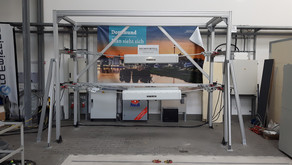MILES - Model of International Energy Systems
The market and grid simulation framework MILES enables techno-economic analyses of the European energy system. MILES covers the entire process of strategic transmission grid development. Thus, MILES forms the basis at the ie³ for studies on the holistic development and evaluation of sustainable energy system designs and transmission grid structures.
The simulation framework is designed as a modular tool chain. MILES comprises as superordinate process steps
- the regionalization as well as the generation of time series of decentralized renewable energy sources and loads,
- the determination of the optimal power plant and exchange schedules,
- the simulation of realistic operating conditions of the transmission grid as well as
- the determination of necessary congestion management measures.
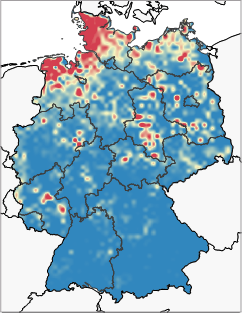
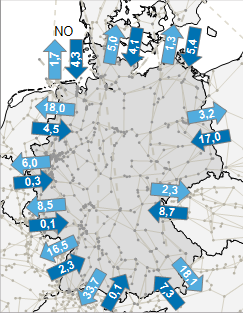
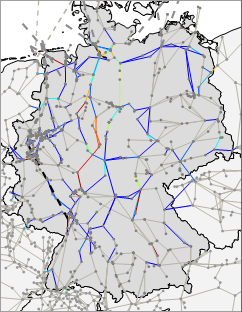
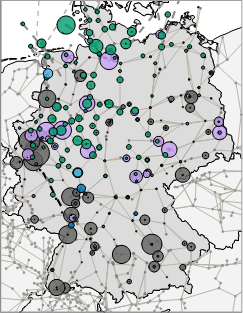
Scenario Generation & Reduction
Energy system scenarios form the basis of network development planning. Scenarios typically include forecasts of future electricity consumption and generation especially with respect to the share of renewable energy sources. Future electricity demand is subject to structural changes, especially against the background of increasing intersectoral interactions due to advancing sector coupling. Due to the increasing electrification of the transport and heating sector and the rising demand for green gases and synthetic fuels, the sole consideration of the electricity sector in scenario generation is no longer sufficient. To generate and analyse divergent transformation paths of the energy supply system, methods and procedures are developed at ie3 and continuously refined within the framework of current research work and applied in practice-oriented industrial studies.
Furthermore, the share of non-dispatchable RES in the system rises, as a consequence power system operation, control and planning has to cope with increasing amounts of uncertainties. Uncertainties in the field of power systems are unplanned outages of thermal units, intermitting generation of renewable energy sources, temperature sensitive electrical load and hydro generation. Hence, the ie³ developed a scenario generation approach to calculate various realizations of hourly power generation and load profiles for the uncertain parameters (wind, solar, hydro and demand) in terms of operational scenarios based on historical climatic conditions of 40 years. The developed scenario generation method applies a Monte Carlo (MC) approach combining realizations of hourly power generation and load profiles based on the climatic conditions of one randomly selected historical weather year with randomized power plant availabilities (outage patterns) to generate samples of the stochastic inputs to model their uncertainty. Subsequently, it can generate a broad variety of so-called MC years to be used as an input for the following MILES modules. Additionally scenario reduction techniques have been developed to identify relevant sub-sets from the total amount of scenarios generated.
Regionalization
The regionalization module of MILES calculates installed capacities at zonal level, starting from national level installed capacities. To distribute installed capacities of renewable energy sources, a top down approach is applied. National territory of each country is divided in sub-regions. Subsequently various statistical figures for each region are analysed to generate regionalization factors. The considered statistical parameters include socio-structural data, land use, location of existing plants and weather related data.
Time Series Generation
Based on these regional assigned capacities the time-series-generation calculates feed-in time series for each region based on historical weather data and characteristical power curves. The weather data are taken from the regional model COSMO-EU of Germany's National Meteorological Service. For the electrical load a historical load profile is broken down by means of regionalization factors and scaled to the targeted annual consumption, to generate spatially disaggregated time-series in each sub-region.
Market Coupling
To determine the cost optimal dispatch of conventional power plants and storages to cover the electrical demand and control reserve needs, a mixed-integer linear program (Unit Commitment) is solved. The optimization considers feed-in of renewable energy sources, market coupling mechanisms as well as technical constraints of generating units. Technical constraints comprise minimum stable generation and maximum rated power, maintenance scheduling, minimum up and downtimes, ramping constraints and maximal storage capacities. The market coupling simulation can consider different capacity models at individual borders. In addition to bilateral, coordinated net transfer capacities (NTC-values), flow-based capacities (in terms of PTDF-Matrices and RAM forming flow-based domains) can be considered. Thus, hybrid market coupling simulations as well as fully flow-based simulations can be carried out with MILES.
The optimization problem is solved by means of a rolling horizon approach. The considered year is split up in overlapping intervals of constant length. Each interval represent the planning horizon of market agents and is optimized sequentially. For this, preceding state-space system parameters at a fixed time step function as the initial phase of the subsequent interval.
Based on the results of the unit commitment problem, fundamental market clearing prices and amount of CO2-emissions of the individual bidding zones as well as total cost of energy supply are determined.
Transmission Grid Operation
Based on the results of the presented market simulation, further network simulations are then carried out to derive the resulting network expansion requirement. The procedure for determining the need for network expansion involves network simulations in the form of (AC) power flow calculations, which are used to identify weak points in the network with regard to the supply and transport tasks set by the network participants. Simulations are carried out both in the basic network state ((n-0) case) and in the (n-1) case, i.e. assuming the failure of any network equipment.
Congestion Management
For the bottlenecks in the network identified on the basis of the operating states, there is then the option of determining the network and system security measures necessary to ensure (n-1) security. These include changes to the operating points of HVDC transmission links and phase-shifting transformers, adjustments to the schedules of conventional power plants and storage facilities (redispatch), the reduction of feed-in power from renewables and CHP plants (feed-in management) and the switching of loads on and off (load management).
Automated Expansion Planning
This module determines a time-resolved, optimal implementation plan for the optimal subset of specified transmission network expansion measures, taking into account technical and logistical implementation restrictions. The objective is to minimize the power-related bottlenecks in the transmission network area during the implementation period.
First of all, the input data, i.e. the list of possible actions, the network model and the corresponding network use cases are loaded within the framework of data preparation and processed and checked accordingly. Then, within the scope of the optional data reduction, a first selection of relevant network use cases can be made in undisturbed operation. Afterwards, the operating points of high-voltage direct current transmission lines (HVDC) and phase shifting transformers (PST), which cannot be controlled within the scope of the final optimization, are determined with the help of a pre-optimization. Taking into account the remaining use cases, the relevant n-1 cases are identified in the main run and when applying data reduction. A reduction of the transmission network model to a smaller (sub)network area relevant for the final optimization as well as a pre-analysis of the overload potentials in form of the maximum possible current-related network overloads is possible within the scope of the data reduction.
Before the final optimization, which determines the optimized expansion and implementation plan as well as the operating points of the controllable internal HVDC transmission and PST, a final use case selection is made for problem reduction. This happens especially when no data reduction is used. In addition, the determined optimal expansion plan can also be used as a starting solution for an iterative re-call of the planning environment, if required, in order to analyze further interdependencies of the transmission network expansion measures. Finally, a graphical representation of the results of the planning environment with regard to the implementation plan and the resulting network loads is provided.
Exemplary Applications

NEMO V

NEMO VI
Publications
Dennis Klein: Optimierungsgestützte Modellumgebung zur Bestimmung des Ausbaubedarfs elektrischer Übertragungsnetze, Dissertation, September 2020
Volker Liebenau: Einfluss der Regionalisierung Erneuerbarer Energien sowie innovativer Konzepte auf die Netzentwicklungsplanung, Dissertation, May 2019
Christopher Spieker: Europäische Strommarkt- und Übertragungsnetzsimulation zur techno-ökonomischen Bewertung der Netzentwicklung, Dissertation, May 2019




